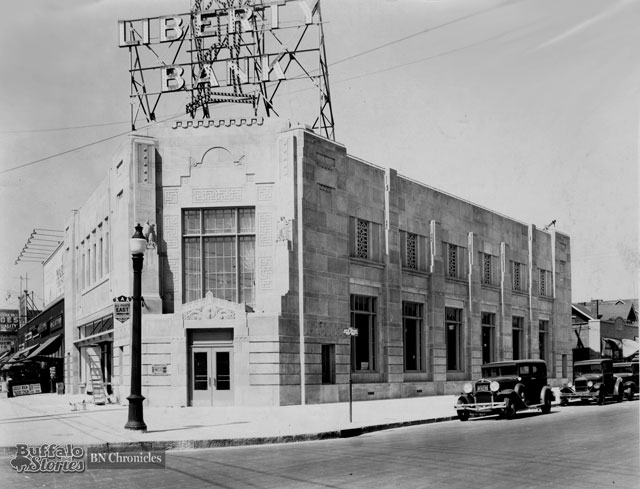 By Steve Cichon
By Steve Cichon
steve@buffalostories.com
@stevebuffalo
“It doesn’t take very long for a newcomer to become acquainted with Buffalo’s banks,” wrote News Reporter Robert J. Summers in 1980. “Stand at a corner like Main and Court, and you can see most of the big buildings where they are headquartered.”
Of the five bank headquarters Summers listed as visible from that intersection, only one remains in business 36 years later.
As the names involved in Buffalo’s banking scene are changing once again, BN Chronicles looks back at the names that might have been stamped on the front of your first savings account passbook or at the top of your first paycheck.

1979 ad. Buffalo Stories archives
Manufacturers and Traders Trust Company was founded in Buffalo in 1856. M&T was and is headquartered in the 318-foot, 21-floor building at One M&T Plaza that opened in 1966. That block has seen plenty of history.

M&T branch on Abbott Road at Stevenson, South Buffalo. (Buffalo News archives)
In 1865, Abraham Lincoln’s body laid in state at the St. James Hotel on the site. The Hotel Iroquois, and then the Bond Men’s store, occupied the north part of the site until 1964. M&T’s headquarters was first built on the southern half of the block now occupied by the headquarters building in 1916.

1964, just before the demolition of the circa-1916 M&T headquarters and Bond Menswear. AM&A’s is in the background. The block with H. Seeberg and the Palace Burlesk was torn down and is now green space. (Buffalo News archives)
In 1980, Marine Midland Bank was Buffalo’s oldest bank and headquartered in Buffalo’s tallest building.

Marine Trust’s Main & Seneca office, 1951 (Buffalo News archives)
Founded in 1850, Marine Midland was the nation’s 12th largest bank with $12 billion in assets in 1980. It was acquired by HSBC Bank in 1999. HSBC sold off its Buffalo-area branches to First Niagara in 2011. By the end of the summer, it’s expected that First Niagara will be acquired by KeyBank. The former Marine Midland Center is now known as One Seneca Tower.

Marine Midland ad for a “groovy Bills bank,” 1969. (Buffalo Stories archives)
Western Savings Bank’s headquarters was right on the corner that Summers chose as his 1980 vantage point for financial institutions. It’s the building with CVS Pharmacy currently occupying the ground floor space that was once Western’s main office.

Western Savings Bank ad, 1979. (Buffalo Stories archives)
While Western joined other area banks in demolishing decades-old Roman-inspired headquarters buildings for flashy new high-rise towers in the 1960s, by the early 1980s, deposits were falling and Western was losing money. In 1981, Western merged with longtime rival Buffalo Savings Bank.

Buffalo Savings Bank opened a temporary branch serving skiers at Kissing Bridge in 1980. Buffalo News archives
Buffalo Savings Bank’s famous gold-domed headquarters, designed by E.B. Green, is the rare survivor of our city’s magnificent bank buildings. As it expanded and acquired outside of Buffalo, Buffalo Savings Bank changed its name to Goldome — as a nod to its great headquarters with a name a bit less parochial sounding.

The Buffalo Savings Bank building with its famous gold dome, photographed in 2009. (Buffalo News file photo)
Like many banking institutions around the country, Goldome grew too quickly and went under during the savings and loan crisis of the late 1980s. In 1991, Goldome’s assets were split between KeyBank — which entered the Buffalo market after Empire of America succumbed to the S&L crisis — and another bank in 1989.

Buffalo Stories archives, 1960
For the same reasons Buffalo Savings Bank became Goldome, “The Big E” changed its name from Erie County Savings Bank to Empire of America in 1981. After nearly a decade of borrowing to acquire other banks around the country, in 1989 Empire told regulators it was insolvent and posted a $158 million loss in the third quarter.

Big E celebrated 125 years in business in 1979. Ten years later, the federal government assumed control of the bank. (Buffalo Stories archives)
As longtime Buffalo banks Buffalo Savings and Big E were busy buying up other deposit bases, longtime Buffalo institution Liberty Bank instead was bought up.

Liberty Bank’s branch at Bailey & Kensington, 1930s. (Buffalo News Archives)
While the twin Lady Liberties atop the bank’s headquarters still stand proudly on Buffalo’s skyline, in 1985 Liberty Bank became Liberty Norstar. Boston’s Fleet Bank bought Norstar in 1987, and in 2004, all Fleet branches became Bank of America branches after those two institutions had merged.

Buffalo Trust, previously known as Buffalo German Bank, was headquartered in a Victorian Italianate structure that was torn down in 1957 to make way for the Tishman building, the longtime headquarters of National Fuel. Today the site is home to a Hilton Garden Inn. (1924 ad, Buffalo Stories archives.)
 By Steve Cichon
By Steve Cichon













